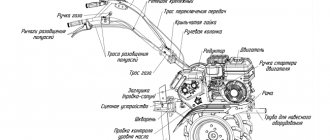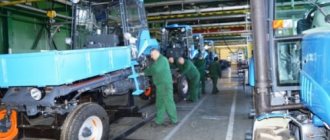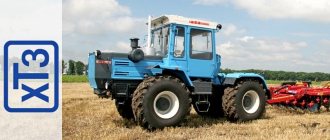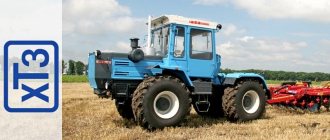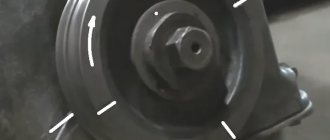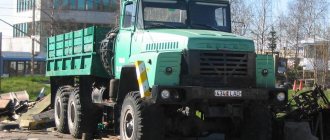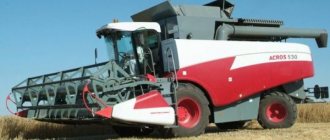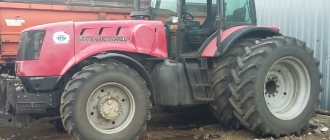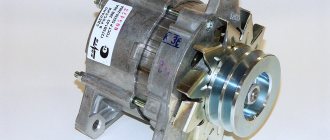The VT-100 tracked tractor is a general-purpose machine that has several modifications with a tractive effort of 3 or 4 tons. Production of this model has long been discontinued, but many copies still work in agriculture, land reclamation, road construction, utilities, construction and transport sectors. And you can buy a completely working unit at a low price.
Truth and fiction
Many years after the end of production of the tractor, its history and descriptions became overgrown with legends.
These legends are not always based on real facts. Let's sort it out in order: T-100 is another name for the S-100 model. Yes and no. These tractors are similar in design. This is easy to verify by comparing the technical characteristics of the S-100 and T-100, descriptions, dimensions and weight. The following parameters will be the same: - Traction force, which is 6000 kg. — The number of gears is five forward and four backward. — Base – 2270 mm. — Track – 1880 mm. — Ground clearance – 391 mm. — Fuel tank capacity – 235 l. — Specific pressure on the ground – 0.47-0.48 kilograms per square centimeter. But the KDM-100 engine, installed on the early model, turned out to be not very successful. The D-108 engine was chosen for the new tractor. It is more powerful - 108 hp. With. versus 100 l. s., and consumed less fuel - 175 g/l. With. h. versus 208 g/l. With. h. The launch was carried out using a P-23 starting unit running on gasoline. A close relative of the tank. There is an opinion that the design of the T-100 tracked tractor used technical solutions characteristic of Soviet tanks of that period. It's a delusion. The construction of ChTZ was carried out with the involvement of specialists from the USA, and proven Caterpillar tractors were used as basic models for creating the first models. To save time, components and assemblies were copied. This was not easy, since in America the inch system was used, and it was necessary to hastily recalculate the dimensions of the parts to the metric system adopted in the USSR. Despite the increased power, weight and dimensions, the design of the T-100 tractor uses the technical solutions of its predecessors - the S-60 and S-80, in which the ideas of Caterpillar can easily be traced. An example of reliability. The popular model of the Chelyabinsk plant cannot be called such. Components with a limited resource and require careful handling. Another thing is maintainability.
Attention was paid to it when developing the design. Most repair and maintenance operations can be performed without high-precision equipment and qualified personnel. This approach of the developers created the T-100M reputation as an indestructible vehicle.
Inferior to models of imported equipment. For its time this is a very progressive design. In terms of technical characteristics, the T-100M tractor was at the level of world standards. Five years after the start of production, the model received a gold medal at an international exhibition. Not powerful enough. 108 l. With. obtained from the D-108 engine, whose displacement was 15.5 liters, do not look impressive by modern standards. For a tractor, it is not the power that is more important, but the torque parameters; everything was fine with that. The power unit, whose speed reached 1070 rpm, has a torque exceeding 800 N.m. The technical characteristics of the T-100M met the requirements of the time. Low comfort. The tractor suspension is made according to a semi-rigid design. This means that the springs were only in the front part, and at the rear the frame was attached to the crawler tracks through hinges. Forced ventilation of the bulldozer driver's workplace was carried out due to the fact that the engine took air from the cabin. Feedback from tractor drivers is clear: such a system became a source of loud noise. In this respect, the model was noticeably inferior to VT tracked tractors
This approach of the developers created the T-100M’s reputation as an indestructible vehicle. Inferior to models of imported equipment. For its time this is a very progressive design. In terms of technical characteristics, the T-100M tractor was at the level of world standards. Five years after the start of production, the model received a gold medal at an international exhibition. Not powerful enough. 108 l. With. obtained from the D-108 engine, whose displacement was 15.5 liters, do not look impressive by modern standards. For a tractor, it is not the power that is more important, but the torque parameters; everything was fine with that. The power unit, whose speed reached 1070 rpm, has a torque exceeding 800 N.m. The technical characteristics of the T-100M met the requirements of the time. Low comfort. The tractor suspension is made according to a semi-rigid design. This means that the springs were only in the front part, and at the rear the frame was attached to the crawler tracks through hinges. Forced ventilation of the bulldozer driver's workplace was carried out due to the fact that the engine took air from the cabin. Feedback from tractor drivers is clear: such a system became a source of loud noise. In this regard, the model was noticeably inferior to VT tracked tractors.
Engine
VT-100 is equipped with 2 types of power plants:
- 4-stroke diesel engine D-442-24 (Altai Motor Plant). The unit has a two-valve gas distribution system, liquid cooling and gas turbine supercharging. The engine cylinders are lined up, making it easier to service and more compact. The level of harmful emissions complies with GOST 41.96-2005 standards. The motor uses liners made of special cast iron with additional processing of the working area, which increases the service life of the motor. The design of the unit allows it to be operated without major repairs for up to 12,000 operating hours.
Characteristics of the D-442-24 engine:
- working volume – 7.4 l;
- design rotation speed – 1750 rpm;
- torque reserve – 35%;
- number of cylinders – 4;
- cylinder diameter – 130 mm;
- specific fuel consumption – 220 g/kW per hour.
- 4-stroke diesel engine SMD-20TA (Belgorod Motor Plant). Among the features of the unit: direct fuel injection, liquid cooling, turbocharging and in-line cylinder arrangement. The engine is highly reliable and can operate in 2 modes: traction and drive. The protection system is triggered at low pressure and overheating (after the signal the unit turns off).
Characteristics of the SMD-20TA motor:
- working volume – 6.3 l;
- rated power in traction mode – 88 (120) kW (hp);
- rated power in drive mode – 106.8 (145) kW (hp);
- design rotation speed – 1900 rpm;
- torque reserve – 25%;
- number of cylinders – 4;
- cylinder diameter – 120 mm;
- specific fuel consumption – 227 g/kW per hour.
Basic faults and repairs
When operating the T-100 crawler tractor, the operator may encounter various malfunctions. The following list shows the most common problems and how to fix them:
- engine running intermittently (not warmed up, lack of fuel, clogged fuel line and filter - warm up the engine, check the fuel level, replace the filter, clean the fuel line);
- engine knock (valve clearance adjustment);
- smoky exhaust (bad fuel, water getting into the fuel, cold engine - warm up, replace fuel);
- increased oil consumption (the location of the piston rings is adjusted, oil leakage is eliminated);
- carburetor malfunctions (adjustment, debugging in progress);
- slipping of the clutch (it is necessary to wash the friction linings with kerosene);
- heating of the brake bands or the brake not working when pressed (repair: adjusting the brakes, washing the side clutches without turning them on).
Tractor VT-100
The author of this unit was the Volgograd (formerly Stalingrad) Tractor Plant, which for a long time was the main supplier of tracked vehicles in our country. The VT-100 model was a continuation and redesign of the popular DT-75 model, receiving an improved cabin, a more advanced engine, a hinged hood and a number of other improvements. To be specific, engine performance, for example, increased by one and a half times, and fuel consumption (per hectare) decreased by one fifth.
A rugged machine launched into mass production in 1994:
- It has an optimal combination of power and weight, and the use of ballast gives it excellent stability. Equipped with a pneumatic servo drive, which makes turning easier.
- It has a balanced spring running system with belt tracks, which makes the movement smooth and the pressure on the soil minimal.
- Allows quick access to the engine and radiator thanks to the hinged hood.
- It can be equipped with tracks of various purposes and widths (rice-growing, row-crop, with asphalt overlays, without lugs).
Easily connects via a hydraulic system to various mounted and trailed devices, including bulldozer equipment.
- It has several modifications (beet-growing, row-crop, swamp).
- Equipped with a spacious two-seater cabin with double glazing, good visibility and comfortable sprung seats.
Important Technical characteristics and features of the T-16 tractor
In general, the tractor showed its best side, proving to be reliable and very easy to operate. The only drawback is that you can’t always find spare parts (not everything from DT is suitable).
Photo of the VT-100 tractor
Outdoor LED lamp A-STREET-100/11200-K 100W from the manufacturer
Description Outdoor LED lamp 100W
Full replacement for DRL-250 Power consumption, W: 100 Luminous flux, lm: 11200 Supply voltage: 176-264V / 50Hz Color temperature, K: 4700-5500
These lamps are an effective and economical replacement for street lamps with DRL 250 lamps. Efficient REFOND LEDs with a working life of more than 100,000 hours are used as a light source. The lamp body is made of aluminum profile, protected from atmospheric influences. An external radiator provides heat dissipation. Used for lighting: - pedestrian sidewalks and roads of category “B”; — parks and squares; — parking lots and gas stations; — railway platforms and platforms; — loading and unloading ramps. Advantages: - energy savings up to 3 times compared to a floodlight with a metal halide lamp; — does not require additional maintenance; — does not require special disposal; — high color rendering index; — the operating life of the lamp is more than 100,000 hours; — guaranteed instant switching on at low temperatures; — the entire chain of LEDs is protected by Zener diodes, which guarantees uninterrupted operation of the lamp, even if any of the LEDs burns out; — optimal price/quality ratio.
Characteristics LED street lamp 100W
| Specifications | |
| Overall dimensions, mm | 530x170x245 |
| Operating temperature range, оС | from -45 to +50 |
| Color rendering index, Ra | > 85 |
| Light intensity curve according to GOST 17677 | cosine D |
| Maximum cross-section of network cable, mm2 | 3*0,75 |
| Net weight, kg | 3,5 |
| Supply voltage, V / Frequency range, Hz | 176-264 / 50 |
| Power consumption, W | 100 |
| Lamp operating life, h | 100000 |
| Luminous flux, lm | 11200 |
| Degree of protection from environmental influences, IP | 65 |
| Glow color | Day |
| Color temperature, K | 4700-5500 |
alprofled.ru
Purpose
Initially, the tractor was supposed to be called S-100M, since it is a deeply modernized S-100. The main modification was equipped with a blade and was a bulldozer.
However, there were other machines based on it:
- T-100MGS – agricultural row crop tractor
- T-100M – tractor with winch
- T-100MGP - modification for construction and industry, had the ability to install attachments at the front and rear
- T-100MBG - the previous modification, created for work in swamps and had wide tracks
- T-100MB – swamp tractor with winch
- T-100T – pipe layer
and many others, such as a crane, pile driver, uprooter, etc. There were more than twenty modifications in total. The tractor was produced at the Chelyabinsk plant from the 60s to the 80s of the last century.
Tractor T 100
Owner reviews
This is what VT 150 owners write on thematic forums:
Stanislav : “I’ve been using the tractor since 2006. For those who are thinking of purchasing it, I advise you to buy it with drum brakes. The disc ones had to be changed after 100 thousand mileage. Yes, they worked for 5 years. What next? It's impossible to find spare parts. Harrowing the soil occurs in two steps. For the first time in days of work, the air intakes immediately broke down. The piston system was changed after 2 thousand hours. In 8 years, I replaced three sets of tracks. Before starting spring work, be sure to adjust the fuel system."
Story
The tractor is a deep modernization of the S-100 tractor. Initially, the tractor was supposed to be called S-100M
(
Stalinets - 100 Modernized
), however, due to the eradication of Stalin's personality cult, it was renamed
T-100M
.
The transitional model from the S-100 tractor to the T-100M tractor is the T-108 tractor, produced from 1962 to 1965. (In fact, the T-108 tractor was never produced; T-108 is one of the names of the experimental tractor, which, upon serial production, was immediately designated T-100M). The first T-100M was assembled on October 9, 1963. In 1968, at an international exhibition, the T-100M tractor was awarded a gold medal. In 1977, production of the basic model T-100MZ
(Z - replaceable) began, using components of the T-130 tractor. The T-100MZ appeared due to the impossibility of quickly transitioning the plant to the production of T-130 tractors, thus releasing a transitional model, ChTZ was able to gradually master the production of new units.
The tractor is equipped with a low-speed four-cylinder four-stroke diesel engine D-108 with high torque, replacing the outdated KDM-100 engine (on the S-100 tractor). In the D-108 engine, the combustion chamber was moved inside the piston, while the KDM-100 had a spherical combustion chamber, consisting of a hemisphere at the top of the cylinder and a hemisphere in the piston.
The T-100M could be equipped with more than two hundred units, including bulldozers, scrapers, rollers, cranes and heavy self-unloading trailers.
Initially, the tractor was designed for use as part of the DZ-53 bulldozer with a rope-controlled blade. Later, the bulldozer equipment was modified through the use of a hydraulic system and received the designation DZ-54. 14 types of additional equipment were produced for the DZ-54 bulldozer: ripper, brush cutter, rock remover, stump remover, extenders, openers and others. The tractor was also used as a chassis for a pipe layer, pile driver and crane.
The tractor was distinguished by a high level of comfort in the cabin for the 1960s. The cabin had lighting, a soft seat, and forced ventilation by sucking some of the air into the engine from the cabin (although this solution led to increased noise in the cabin). To refuel the tractor, a vacuum device was used, powered by the energy of exhaust gases, allowing refueling from containers located below the level of the fuel tank. Its volume was 235 liters.
The T-100M tractor was widely used on Soviet construction projects in the 1960s–1980s (both large and small). Some machines of this type are still in operation (about 150 copies were in use in Hungary in 2006). The name T-100 actually became a household name for later models such as the T-130, T-170 and T-10. In turn, the T-100M tractor was often traditionally called the S-100.
The D-108 engine of the T-100 tractor is widely used on other types of construction equipment (compressor stations, diesel generators, as well as on excavators of the E-10011 family and its modifications).
The tractor was also supplied to agricultural enterprises, but was not widely used there due to its too low speed compared to specialized agricultural tractors.
Specifications
Sotka had technical characteristics that allowed it to work in the most difficult conditions:
- Propulsion type – caterpillar
- Traction force – 10 tons
- Engine – diesel
- Cabin location is rear, engine location is front
- Onboard brakes and clutches that allow you to control movement
- Stiff suspension
- On-board electrical network – generator 200W, mains voltage – 12V, headlights – 4, there is lighting inside the cabin
- Speed – from 3 to 10 km/h
- Number of forward speeds – 5, reverse – 4.
Be sure to read: Shantui SD22 bulldozer
More specific technical specifications vary depending on each model. The technical characteristics of the T 100 made it an excellent working tool where significant traction and high power were required.
Engine characteristics
Engine – D-108, diesel, water-cooled with a closed-type steam-air valve. Engine power – 108 hp. The engine is very massive, the rigidity of the parts makes it a “long-liver” among engines - there are cases when these engines were actively used for 50 years without major repairs. This engine was installed not only on tractors - it was also used on excavators, diesel generator stations, and other machines.
The engine is started using a two-stroke carburetor starting engine, which is located on the side of the main one. This system allows you to start the tractor even when it is 50 degrees below zero outside. Of course, you should use winter diesel fuel. Warming up and starting takes from a few seconds to half an hour.
- Rated power – 108 hp.
- Number of cylinders – 4
- Operating order – 1-3-4-2
- Cylinder arrangement – vertical
- Compression ratio of the fuel mixture – 14
- Idle speed – from 500 to 1140
- Fuel - diesel fuel, GOST 305-62. Summer or winter, depending on the time of year.
- The fuel pump is gear-type with a centrifugal regulator.
- There is a fuel filter for coarse and fine cleaning.
- The minimum torque on the shaft is at least 75 kgf per meter.
T 100
Cabin
The tractor has a closed, rigid single-seat cabin. The cabin is equipped with an inclined windshield and windshield wipers. The seat is soft. The cabin is equipped with a heating system.
Fuel consumption
Fuel consumption – 174 g/l.h.h. Consumption, like any tractor, depends on the work performed. Maximum – slightly less than 2 liters. at one o'clock. On average, under normal operating conditions, the consumption of the Sotka tractor does not exceed one liter per hour. The C 100 bulldozer left this tractor with a rigid suspension.
Important The best models of gasoline and electric trimmers Husqvarna
Be sure to read: Bulldozer B10m
When working, the tractor driver experiences a significant number of shocks and shocks. However, considering that the maximum speed of the tractor is 10 km/h, these vibrations and shocks rarely have much force, and in most cases the tractor driver feels quite comfortable on a soft chair. The T-100MGBP model has a cabin equipped with hydraulic steering and clutch power steering, which greatly facilitates the work of the tractor driver.
UMZCH with a power of 100W CAVR.ru
Share in:
UMZCH WITH POWER 100w
Technical characteristics of UMZCH:
1. Maximum output power when operating with a 4 Ohm load…….100w.
2. Maximum output power when operating with a load of 8 ohms……. 60w.
3. Frequency range with uneven characteristics not worse than 3 db and power 25w.....14-100000 Hz
4. The noise level is no worse than…………………………………………….. -80 db.
5. Constant output potential no more than…………………………………… 0.04v.
6. SOI at output. power 50 w, load 8 Ot at a frequency of 1 khz no more than... 0.04%.
7. Voltage gain when operating at a load of 8 Ohms…….36 db.
8. Supply voltage……………………………………………. ±15…±35v.
The circuit diagram of the amplifier is shown in the figure above. To obtain high power and reduce the risk of failure of the output stage transistors, a pair of identical transistors tip36c and tip35c are used in each arm of the output push-pull cascade circuit, according to the structure. To ensure uniformity of currents through parallel-connected transistors (which may have differences in parameters), equalizing resistors r16-r17 and r18-r19 are included in the emitter circuits of the transistors. The output stage circuit has a feedback circuit that regulates the gain depending on the resistance of the speaker system connected at the output. The resistance sensor is resistor r26 connected in series with the speaker system. The alternating voltage from this resistor is supplied to the base q2 through capacitor C4. This circuit is designed to protect the output from a short circuit in the load. The protection limits the output current to no more than 8.5A. When such a load current occurs, the gain decreases sharply. The control value at which the gain decreases is an alternating voltage of more than 1v across resistor r26.
This provides protection against short circuits in the load and overload of the output stage.
The input signal is supplied to one of the inputs of the differential stage on transistors q1 and q2. In this case, the second input is used to supply an error signal.
The mode is adjusted by a regulating cascade using transistor q12 and resistor rv1. Transistors q4 and q5 serve to stabilize the output stage mode for direct current. The current sensors are resistors r20 and r21. Transistor q12 practically must be placed between the radiators of the output stage transistors so as to be mechanically pressed between them. It is a sensor for exceeding the temperature of the output transistors.
The amplifier's quiescent current is set at 25 tA (with resistor rv1).
Other powerful transistors can be used in the output stages, for example, mj15003 and mj15004, respectively, as well as tip3055 and tip2966, mje3055 and mje2955. All resistors r16, r17, r18, r19, r26 must have a power of at least 5w, and resistors r20 and r21 must have a power of at least 10w. In principle, r20 and r21 can also be used at 5w, but when operating at a power close to the maximum, they will heat up, but within the tolerance. However, in this case they need to be located away from each other and from the heatsinks of the output transistors so that they do not overheat.
All diodes are of the 1n4004 type (or others within the range of 1 n4001-1 n4007, it is important that they are all the same).
BC549 transistors can be replaced with KT3102, and BC559 transistors with KT3107.
The second picture shows the power supply circuit. The circuit is simple, based on a low-frequency power transformer without a voltage stabilizer. For the stereo version, a ready-made toroidal transformer with a power of 300w is used, generating a secondary voltage of -25v+-25v (that is, a 50-volt winding tapped from the middle). Maximum current - 6A. You can use another option, for example, a transformer with an W-shaped core or a converted transformer from an old tube color TV. In the monophonic version (if, for example, this ULF will work as an ULF of a common low-frequency channel), the power of the transformer and, accordingly, the output winding current can be two times lower. You can use a transformer with a lower output voltage, the amplifier will work, only the maximum power is reduced. But I do not recommend choosing a transformer with secondary windings giving more than 27+27v, as this may damage the output stage.
The rectifier bridge is made using 10A02 diodes. You can use any other rectifier diodes or bridge assemblies for a direct forward current of at least 8A and a reverse voltage of at least 70v. Filtering electrolytic capacitors must have a voltage of at least 50v. It is advisable to use a capacitance of 10,000 µF or more, but 4,700 µF is quite sufficient. When setting up, it is advisable to use a powerful bipolar laboratory power source. Connect the assembled amplifier with installed radiators to this power source (amplifier without load, that is, without speaker systems) and supply power somewhere around ±15v. After this, check all parts for heating. Nothing should get hot. Observe the current consumption on the power supply ammeter and gradually increase the voltage to ±25v. If at any moment the current begins to increase sharply, turn off the power and check for correct installation. If the current increases smoothly and slightly, continue increasing the voltage to ±35v. The constant voltage at the output should be no more than 0.1v.
Measure the collector currents q10 and q11, this can be done by measuring the voltage on r20 and r21, the current should be 25 mA (voltage across 11-13mv resistors). Installation with resistor rv1.
Now connect the speaker system. The constant voltage across it should not be more than 0.15v.
If resistor r22 heats up, this indicates self-excitation of the HF amplifier.
The installation is carried out on a prototype printed circuit board measuring 140×100 mm. The part of the board where the output stage parts are located has been modified - holes of a larger diameter have been drilled, and the area of the tracks has been increased by soldering adjacent pads with solder and applying tinned braid from a shielded cable. This mainly concerns the installation locations of low-ohm power resistors and conductors going to the output transistors. These conductors should be the shortest and made of thick copper wire (with a cross-section of at least 1 mm). The location of the parts on the board is very close to the location of their symbols on the circuit diagram. We can say that during installation I used the circuit diagram as a wiring diagram. The difference is that the low-resistance resistors are rotated 90 degrees compared to how they are shown in the circuit diagram
Nikitenko A. P.
Section: [Low frequency power amplifiers (transistors)] Save the article in: Leave your comment or question:
www.cavr.ru
Possible faults
During operation of the machine, various types of malfunctions may appear. Most of them do not require serious intervention and can be eliminated in the shortest possible time.
- The car engine is unstable. There may be several reasons for this. First of all, you need to make sure there is fuel in the tank. The most common possible malfunction is a clogged fuel line or filter. Also, interruptions in operation may be caused by the fact that the tractor engine did not have time to warm up sufficiently. Accordingly, to troubleshoot problems, you need to warm up the engine, clean the fuel system and replace the filters.
- The engine began to knock. This problem can be solved by adjusting the valve clearances in the tractor.
- The brake bands get hot or the car brake does not work. Flushing the side clutches and adjusting the brakes will help here.
- Increased oil consumption. In this case, it is necessary to inspect the system for leaks and check the condition of the piston rings.
- Excessive smoke from the tractor exhaust pipe. Here the cause should be sought in the quality of fuel or water entering the system. If the engine is warm enough and the color of the smoke has not changed, it is recommended to replace the diesel fuel.
- The T-100 carburetor often fails. If the tractor malfunctions, it should also be checked.
Features of operation and maintenance
The T100 tractor must be operated according to universal rules (suitable for all crawler tractors):
- operate the equipment only while sitting in the operator’s seat;
- climb into the cabin only in the designated place, holding the handle near the cabin door and placing your foot on a special side platform;
- before starting work, make sure that there are no foreign objects in the tractor’s path of movement;
- to stop the device, use the brakes, first moving the gearshift lever to the neutral position, and only then engaging the brake;
- lower the implements after stopping the tractor;
- To maintain tracked mechanisms in proper condition, use special oil/grease;
- For operator safety, track tension is monitored visually, at a short distance from the tractor.
Oil or grease comes out of the release valve under high pressure and may cause injury if it comes into contact with the skin, so do not look at the release valve.
Maintenance of the T-100 caterpillar tractor is carried out according to the scheme:
- first service after 7 working hours (at the end of the shift);
- then after 120, 180, 240, 300, 360, 400 hours.
Actions performed by the operator during maintenance:
- clutch adjustment;
- adjusting the brake pedals;
- cleaning the outer surface of working units;
- replacing fuel filters;
- track adjustment (tension level).
When preserving a tractor for winter/seasonal storage, perform the following actions:
- drain the coolant;
- drain fuel sediment;
- all other fluids (from the windshield wiper reservoir, condensation from the air cylinder);
- move the control levers to neutral;
- turn off the battery;
- Place supports (beds) under the tractor so that the caterpillar part does not come into contact with the ground.
Model range and modifications of T100
The level of technical capabilities of the T100 tractor allowed the manufacturer to release 22 modifications based on the flagship model. The model range included the following types of equipment, which later became popular:
- T-100M - the model, which is officially called the basic one, did not have hydraulic equipment and was not designed for the installation of rear-type hitches;
- T100MGS - with hydraulic equipment and rear equipment mounting system, PTO shaft, main purpose - agricultural;
- T100MGP - with gyro equipment and a front linkage system, there is a rigid coupling, a PTO shaft, the main purpose is industrial;
- T100MB - main purpose - swamp, the total area of the caterpillar track has been increased;
- T100MBG - swamp version of T100MGP;
- T100T - main purpose - work with a pipe layer (no mounted systems);
- T-100МГП-1 - lightweight hood, no cabin, modification of МГП100;
- T-100MZ - analogue of T130;
- T-100MZB - main purpose swamp, analogue of T130;
- T-100MZGP is the latest modification in the model range. It was equipped with hydraulics to simplify the turning process, making it easier to operate.
Price
The VT-100 model has been discontinued, so it can only be purchased on the secondary market. There are not many offers here and prices depend on the year of manufacture and condition:
- 1995-1997 – 130-250 thousand rubles;
- 2003-2005 – 320-550 thousand rubles.
Crawler tractors are general-purpose machines that are designed for use on different types of road surfaces. This technique is widely used depending on the installed equipment. Most often, machines of this type are equipped with a mounted system for cultivating fields, working with mining materials, and also for carrying out loading activities. The equipment can be used in construction, agriculture and public utilities.
Model features
The peculiarity of the S-100 tractor engine is that it used pre-chamber mixture formation. That is, the injectors did not inject directly into the cylinder, but into a separate combustion chamber that was screwed into the cylinder head. The combustion of the fuel mixture began in this chamber, and then passed into the cylinder. A fairly standard technical solution for that era, which made it possible to simplify the design of the injectors to the limit, as well as ensure stable operation of the diesel engine at low compression values.
The exhaust pipe of the starting engine passes through the intake manifold of the main engine, which improves the starting characteristics of the diesel engine.
The clutch is designed interestingly. It is not constantly closed, but has two positions: working and idling. It is controlled by a lever located next to the gear shift knob. The clutch itself is connected to the main shaft using a shockless clutch made of five packages of rubber strips. This protected it from damage when the shafts were misaligned.
The advantage of the motor design was its simple and stable start. Even in the conditions of the far north, the procedure took place without complications. It is interesting that after a deep modernization of the basic design, the resulting modification of the T-100, with a general improvement in performance characteristics, started noticeably worse in winter.
Tractor T-100
The disadvantage of such an engine power system is increased fuel consumption.
The clutch is not constantly closed and is characterized by increased safety - even if the reverse lever is not completely turned off at the moment the engine starts, movement of the tractor is excluded. Not to mention the great reliability of the unit.
In general, the entire design is as simple as possible, maintainable and practical. Nothing complicated or fragile, everything is extremely easy to adjust. A high-power launcher made it possible not only to start the engine, but also to work as a self-puller - when a minimum stroke was required.
The only downsides are increased fuel consumption (as already mentioned), poor cabin ergonomics and poor attention to climate issues - still, a wooden top with a canvas tire is not enough for driver comfort. But this is by modern standards
It is important to buy a trencher for a walk-behind tractor or make it yourself
Machine modifications
There were few versions of the tractor produced and they were all similar. Only the length of the base and the suspension system differed:
- S-100. Basic model adapted for agriculture. The dry weight of the S-100 tractor is 11,400 kg. Fully fueled - 11850 kg. The length of the caterpillar is 36 tracks, the pressure on the ground is 0.5 kg/cm2.
- S-100B. Swamp variation with an enlarged base. The number of tracks has been increased to 40, the track width is larger. Ground pressure reduced to 0.24. The width of the shoes has been increased from 500 mm to 1000.
- S-100BH. An improved version of the swamp vehicle with an additional 6th forward speed. An anchor device with a winch is provided.
- S-100GS. A variant of the machine with a rear independent hydraulic drive for working with agricultural implements (trailed, mounted). The number of tracks in the belt is 37.
- S-100GP. Like the S-100GS, but the hydraulic drive is located at the front, since this modification was intended for industrial use. The front guide wheel has a reinforced design. The springs have also been strengthened. The maximum weight of the S-100 tractor in the swamp vehicle variation is 12,100 kg.
- T-100. Basic model, subjected to deep modernization. The ergonomics of the workplace has been improved, fuel consumption has been reduced to 180 g/l hour. The variation was produced from 1963 to 1983.
Modification of the S-100 tractor
Characteristics
All modifications of the S-100 tractor have approximately the same technical characteristics. Excludes ground pressure, base length and curb weight.
| Specifications | Meaning |
| Nominal pulling force | 6000 kg |
| Traction force in first gear | 9000 kg |
| Traction force at maximum gear | 1500 kg |
| Width | 3260 mm |
| Height | 3059 mm |
| Length | From 4255 mm with a trailed one in the basic version and up to 5793 mm in the 100BH modification |
| Number of forward/reverse gears | 5/4 |
| Forward speed range | 2.36-10.15 km/h |
| Reverse speed range | 2.8-7.65 km/h |
| Engine | KDM-100, four-stroke water-cooled diesel, uncompressor, with pre-chamber mixture formation |
| Fuel consumption | 210 g/l hour |
| Starting motor | Gasoline, four-stroke, P46, 18 hp. |
| Fuel tank capacity | 235 l |
| Normal oil pressure | 1.7-2.5 kg/cm2 |
| Transmission | Three-way, reversible, with bevel final drive |
| Turning clutches | Dry, multi-disc |
| Brakes | Belt, with friction linings |
Tractor T-100: technical characteristics
The T-100 was the product of a modification of the industrial Soviet tractor S-100. The main changes affected the cabin, engine, hood shape, replacement of electrical equipment and track mechanism. Several configurations of the car were available to the consumer. Later, the manufacturer released a model line of modified equipment for special work. The basic version of the T-100 is a general purpose tractor. Machine type: crawler tractor.
Engine
The T-100 tractors were equipped with the D-108 engine. The unit became the basis for the processing of previous models. The four-stroke four-cylinder engine featured an integral combustion chamber design, which was placed directly in the piston. The rated power of the car was 108 hp. and was achieved at a crankshaft speed of 1070 rpm.
The working volume of the T-100 cylinders was 15.53 liters. The diameter of one cylinder out of four was 145 mm, the piston stroke was 205 mm. The power unit had a mass of 2100 kg. For particularly difficult conditions, the manufacturer has provided at least 10% torque reserve. For starting in the cold season, the diesel engine was equipped with a P-23 starting engine with an electric starter. To meet the power requirements of the power unit, a fuel tank with a capacity of 235 liters was installed on the machines.
The T-100 starting engine began to be used on industrial machines for the first time. The design of the main engine of the D-108 also differed from the design of its predecessors. In the engine injectors, instead of one spray hole, they began to make five. The Chelyabinsk plant added a jet centrifuge to the oil filter.
The reduced compression ratio in the new D-108 made it easier to start the machine. Maximum torque was increased to 82 kgm. Increased power of the power unit was achieved due to improved mixture formation and fuel combustion in the piston crown chamber.
Transmission and chassis
The T-100 transmission was not very different from the similar unit of the predecessor S-100. Here, a clutch was used, installed as a separate, easily dismantled unit. The clutch is a dry single-disc with two driven discs with a lever-cam control mechanism. A special lever was installed in the driver's cabin to control the clutch.
The gearbox with a mechanical shift system had five forward gears and four reverse gears. Three-way gearbox, reversible. The central gear is a bevel gear, the drive gear is made in a single unit with the lower shaft of the box. The driven gear was attached to the flange of the central gear shaft.
The rotation couplings had a dry multi-disc device. The driven disks were made with friction linings, which were controlled by servo levers. Using a transmission and engine, the T-100 tractor could move in a speed range of 2.36-10.13 km/h forward and 2.79-7.61 km/h backward.
The running mechanism of the semi-rigid type machine consisted of two tracked bogies, a balancing device and tracks. Welded trolleys with a welded box-section frame. The track chain was installed on the support and support rollers and was supplemented with a tension mechanism and an idler wheel. The chain consisted of individual links secured to each other by bushings and pins. Track shoes with a special profile were attached to the links. The balancing device was a spring plate with two smaller stabilizing springs.
Cabin
The cabin of the T-100 tractor was installed on a rigid frame. The only difference between the cabin and the previous S-100 model was its shape. For its time, the tractor was considered quite comfortable. There was lighting inside the cabin and a soft driver's seat was installed. Also, the T-100 was equipped with a forced ventilation system, which, however, led to increased noise in the cabin.
dimensions
- length - 4255 mm;
- width - 2460 mm;
- height - 3059 mm;
- track - 1880 mm;
- length of the supporting surface of the tracks - 2370 mm;
- ground clearance - 331 mm;
- specific pressure on the soil - 0.47 kgf/cm2;
- specific metal consumption - 102.7 kg/hp;
- rated towing force - 6000 kg.
The T-100 tractor had a weight in the design position of 11,100 kg. The maximum towing force of the car was 9500 kg in first gear. As the speed increased, the traction force decreased. In the last, fifth gear, the tractor produced a force of 2000 kg.
Device
Engine
The two main modifications differ precisely in the type of diesel engine. Thus, the name VT-100D means that the tractor is equipped with a D-442-24 engine produced by the Altai Motor Plant. And the VT-100N model is characterized by the SMD-20TA engine. However, both engines are of the same type - gas turbine supercharged and liquid cooled, differing in a few parameters.
The four cylinders of the engine located at the front of the tractor are lined up. This makes the diesel more compact and simplifies its maintenance. There is a two-valve type gas distribution mechanism. Operation is possible in two modes: drive and traction.
A special protection system is triggered when overheating or low pressure occurs. First, a signal is heard, and then the engine is turned off using
solenoid valve.
Transmission
The unit has a five-speed gearbox with permanently meshed gears. There is a high pressure forced lubrication system from the NSh-10 pump. The standard equipment includes a creeper, which allows you to increase the number of gears fivefold. It can be equipped with a reversible gearbox with a movable gear-type mechanism.
To carry out the rotation, a planetary type transmission is used. Driven gears with floating rings are used for final drives. The balance spring suspension has four rollers on each side.
Electrics
The voltage on board the crawler tractor (provided by the DC generator) is 12 volts. There are headlights in the rear and front parts, a lamp in the cabin, a lamp for illuminating the instrument panel, and sockets. The electrical system also includes a battery. There is a sound alarm system.
Hydraulics
The hydraulic system is built according to the separate-aggregate type. It consists of a hydraulic distributor (located at the rear, on the right wing), a gear pump, a tank and hydraulic cylinders. Hydraulics are mainly used to control mounted implements. In particular, a bulldozer blade.
Steering
You can vary the number of revolutions of the diesel shaft using a lever and a pedal. To turn, two levers and two pedals are used, which stop the moving tracks. When the clutch is engaged, the car stops or moves very slowly.
If you increase the number of revolutions, the tractor speeds up. Stopping is done in reverse order. Emergency braking is performed using the pedal.
Attachments
The complete tractor has a power take-off shaft designed for two speeds: 1000 and 540 rpm. Removable weights are placed in the front for balancing. For use in industrial conditions, the machine is equipped with a D3-42 bulldozer blade with a weight of 0.8 tons, a blade width of 2.56 meters, and a height of 0.8 meters.
As for agricultural equipment, you can use any (both hydraulically and non-hydroficated) that is designed to work with tractors of this class (3 and 4). Some units are hung from the front, others from the rear.
